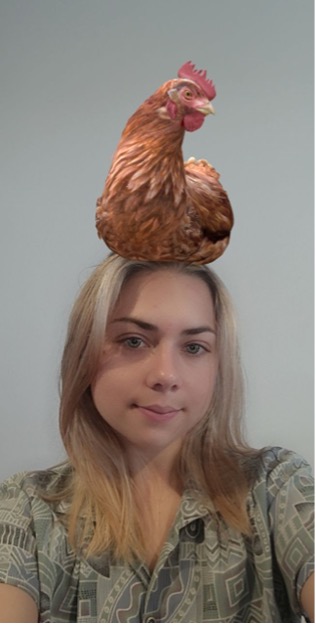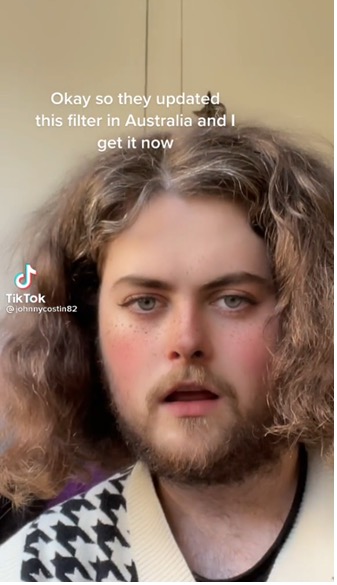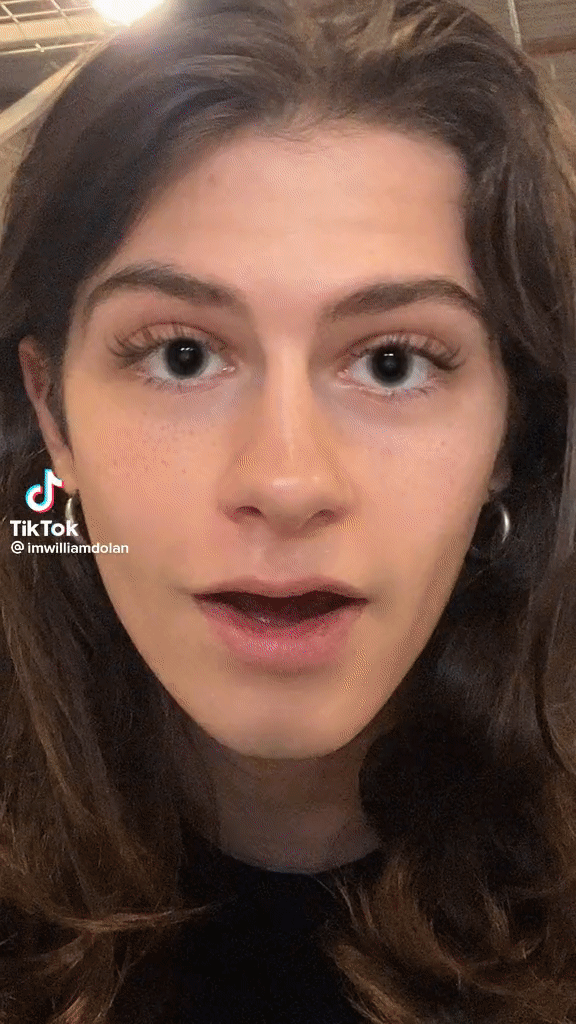The Ambivalence of Beauty (Filters) in AR: Gender Exploration & Selfie Culture

‘Pop Beauty Stains, Filter” Heemsbergen L. 2023 (Midjourney)
While using apps like TikTok or Instagram, if you decide to include an augmented reality (AR) filter (or lens) onto your image the top filters that come up, algorithmically targeted to users, will almost always include at least one ‘beauty filter’. A beauty filter is an AR filter which affords real time facial augmentation in ways that seem designed to align with and reinforce heteronormative western beauty standards. For example, they clear or smooth a user’s skin or add make-up. Beauty elements such as these offer the ‘default’ effects coded into many AR filters, whether they are advertised as heteronormative ‘beauty’ or not. Filters hold great capital and popularity within these platforms, often being necessary to partake in popular trends; regardless of whether users ask to be ‘beautified’.
Take, for example, the classic ‘Chicken filter’ on Snapchat. At first glance, this filter appears to simply add a chicken to the user’s head in a humorous manner. However, this filter also significantly smooths the user’s skin and adds a small layer of make-up to the face. This example highlights the beauty filter themes as a default – a filter which primarily aims to be ‘silly’, or ‘fun’ also smooths out and beautifies a user’s face. Filters hold great capital and popularity within these platforms, often being necessary to partake in popular trends; regardless of whether users ask to be ‘beautified’, or not. This article delves into the complexities of AR beauty filters, moving beyond the simplistic debates about vanity and authenticity to explore the nuanced possibilities they offer.

“Filters hold great capital and popularity within these platforms, often being necessary to partake in popular trends; regardless of whether users ask to be ‘beautified’, or not”
The ensuing moral panics surrounding the beauty filter and its impact on young women’s self-image are undoubtedly valid and well researched (Elias and Gill 2018; Morley 2022; Cug et al. 2022). However, to broaden our understanding of these filters, we must also acknowledge their potential for open-ended, creative gender exploration by all users.
Through a material-theoretical lens, the best place to start to make sense of the impacts of the beauty filter is the selfie. This is because a beauty filter is primarily applied to a selfie image. Since its introduction into academic discussion, the selfie has been framed as a creative, empowering and expressive tool ‘used in one’s ever-evolving project of the self’ (Tiidenberg 2016, pg. 1576; Walker-Rettberg 2017; Senft & Baym 2015;). This is in response to the mainstream media moral panics that portray selfies as narcissistic, vain and frivolous. Senft and Baym (2015, pg. 1590), also counter the conceptualization of selfies as ‘only acts of vanity and narcissism’, and state that the selfie consists ‘of far more than stereotypical young girls making duck faces in their bathrooms’. This argument is significant in shifting historical social perceptions of selfies, as more than just trivial acts performed by younger women.
Rather, selfies warrant significant social and political power which questions boundaries of agency and self-empowerment for users within digital contexts. Burns (2015, pg. 1720), also unpacks the criticism surrounding selfie-taking by stating: “Once the selfie is established as connoting narcissism and vanity, it perpetuates a vicious circle in which women are vain because they take selfies, and selfies connote vanity because women take them.” Other literature argues that we should not situate selfies as inauthentic or frivolous due to the large commercial influence they have within influencer culture. Influencers use selfies as part of their promotional practices, using nuanced practices like ‘subversive frivolity’ to subtly embed endorsements and advertorials within their images (Abidin, 2016 & Hawker and Carah 2019). In these capitalist incentive structures, heteronormative filter augmentations provide utility for users to benefit.
However, the increasingly widespread and varying uses of AR beauty filters requires us to expand this theoretical framing. It is important to note that using beauty filters is a valuable and valid form of self-expression – however we must make this point without constructing a negative view on the playfulness and frivolity selfies enable. The focus to frame selfies and filters as much more important than just a playful and frivolous activity dismisses a large part of the social enjoyment and self-exploration all users can have through these practices, which I expand on below.
First, we need to consider gendered differences in beauty filter use. We now see more users being able to conform to previously unattainable beauty standards through the beauty filter. Furthermore, it is important to note historically, the preferred gender representation of a user quite strongly influenced how they engage with and apply beauty filters. Over the past few years, beauty filters have been typically only applied by feminine-presenting and non-binary users. Masculine-presenting users did apply beauty filters; however, this was often perceived in an ironic or subversive manner. This is because the ‘male’ body is inherently more open to ironic appropriations, whereas the female body is often viewed within a ‘hetero-sexy’ frame (Albury, 2015 & Dobson, 2011). Hetero-sexy refers to ‘imagery, iconography, and decorations’, which ‘reinforce current notions of feminine gender performativity as “sexualised”’ (Dobson 2011, pg. 1). So therefore, while women, men and non-binary users all did apply beauty filters in both ironic and sincere ways, it was technically and socially more difficult for women, and some non-binary presenting users to apply the filters in a humorous or subverting manner. However, these historical boundaries are rapidly shifting.

Figure 2 shows a masculine-presenting user applying the ‘Faux Freckle’ filter on TikTok. The user states they are excited as the filter is now available in Australia. Interestingly he is not using the filter in an ironic manner, but rather using it ‘sincerely’. This user is now the top post for this filter and the associated sound on TikTok and his comment section is full of women stating, in as many words, “I can’t believe how much better this looks on him than me”. It is becoming increasingly common for masculine-presenting and non-binary users to apply conventionally feminine beauty filters in sincere ways. This blurs the boundaries surrounding who can look feminine within online spaces.
Figure 3 demonstrates a non-binary presenting TikToker applying a beauty filter. At the beginning of the clip the music they are playing is quite feminine and pop-like. Then when they step backward and show their masculine frame, heavy metal like music begins playing. This TikTok user does not ever disclose their gender or pronouns and their content primarily revolves around people guessing this. This account’s content is centrally focused on using TikTok filters to play around with and obscure their gender orientation. The beauty filter is now so immersive and realistic that it can achieve both masculine and feminine looks, convincingly, while applied. This further demonstrates the intricate and contextual ways in which the beauty filter is applied to various gender performances. This then also impacts our framing and understanding of selfie-taking practices.

The inclusion of masculine-presenting users in this practice allows us to shift from some original moral panics that framed selfie-filters practices as just trivial acts performed by women. Now both men and women are using them to obscure and ‘play’ with gender. We cannot label these culturally significant acts of self-expression to a simplistic binary of ‘good or bad’ which does not consider the nuanced and complex applications which they allow. Rather, if we embrace the complexity of what it means to take a selfie with a beauty filter, we open it up to more applications from feminine-presenting users without the fear of judgement.
References
Abidin, C. (2016). “Aren’t These Just Young, Rich Women Doing Vain Things Online?”: Influencer Selfies as Subversive Frivolity. Social Media + Society, 2(2), 205630511664134. https://doi.org/10.1177/2056305116641342
Burns, A. (2015). Self(ie)-Discipline: Social Regulation as Enacted Through the Discussion of Photographic Practice.
Carah, N., & Dobson, A. (2016). Algorithmic Hotness: Young Women’s “Promotion” and “Reconnaissance” Work via Social Media Body Images. Social Media + Society, 2(4), 205630511667288. https://doi.org/10.1177/2056305116672885
Highfield, T., & Leaver, T. (2016). Instagrammatics and digital methods: Studying visual social media, from selfies and GIFs to memes and emoji. Communication Research and Practice, 2(1), 47–62. https://doi.org/10.1080/22041451.2016.1155332
Jones, A. (2002). The “Eternal Return”: Self‐Portrait Photography as a Technology of Embodiment. Signs: Journal of Women in Culture and Society, 27(4), 947–978. https://doi.org/10.1086/339641
Marwick, A. E. (2015). Instafame: Luxury Selfies in the Attention Economy. Public Culture, 27(1 75), 137–160. https://doi.org/10.1215/08992363-2798379
Rettberg, J. W. (2014). Seeing Ourselves Through Technology: How We Use Selfies, Blogs and Wearable Devices to See and Shape Ourselves.
Senft, T., & Baym, N. (2015). What Does the Selfie Say? Investigating a Global Phenomenon.
Tiidenberg, K. (2016). Boundaries and conflict in a NSFW community on tumblr: The meanings and uses of selfies. New Media & Society, 18(8), 1563–1578. https://doi.org/10.1177/1461444814567984
Morley, N. 2022, “Beauty Apps for Digital Self-Monitoring and Self-Tracking: Expressive Gestures and Movements, Negative Moods and Emotions, and Visual and Haptic Imagery”, Journal of Research in Gender Studies, vol. 12, no. 2, pp. 63-78.
Cug, J., Tanase, A., Stan, C. I., & Chitca, T. C. (2022). Beauty Filters for Physical Attractiveness: Idealized Appearance and Imagery, Visual Content and Representations, and Negative Behaviors and Sentiments. Journal of Research in Gender Studies, 12(2), 33–47. https://doi.org/10.22381/JRGS12220222
Recommended citation
Hawker, K. (August, 2023) Title. Critical Augmented and Virtual Reality Researchers Network (CAVRN). cavrn.org/the-ambivalence-of-beauty-filters-in-ar-gender-exploration-selfie-culture/
